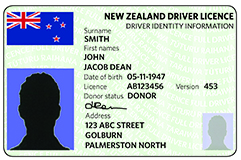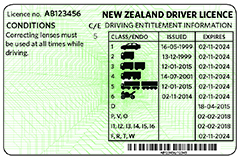New Zealand has a driver licensing system to make sure that everyone who drives on our roads has the skills and knowledge necessary to be a safe driver. The safer drivers are, the safer our roads will be.
A licence to drive a motor vehicle is a privilege that is only given to people who pass the driver licence tests and demonstrate respect for the rights and safety of others.
Photo driver licences help identify drivers. They are one of the best ways to catch unlicensed and disqualified drivers.


A special condition may apply to all or to only some of the classes and endorsements held. If no specific classes or endorsements are listed, the special conditions recorded apply to all.
If your licence is issued with conditions on it, this means that you must follow them when you drive. The reason some people have conditions on their licence is because they may not be a safe driver unless they follow the conditions. If you do not follow the conditions you could be issued with a ticket and receive demerit points and a fine.
A common example of a licence condition is that the driver must wear correcting lenses (eg glasses) when they drive.
Other conditions include driving only automatic vehicles or driving only specially adapted vehicles.
Licence conditions are printed on the reverse side of your photo driver licence.
Note: additional conditions that must be followed by drivers on a learner licence are not recorded on the reverse side of your licence.
There are six classes of driver licence in New Zealand. Each class covers different types and weights of vehicle. That’s because the skills you need to drive a truck are different from the skills you need to drive a car or motorcycle.
Before applying for a Class 2 licence, you will need a full Class 1 licence. The classes relevant for heavy vehicles are covered below.
The holder of a Class 1 learner or restricted licence can drive:
The holder of a Class 1 restricted licence can also drive:
The holder of a Class 1 full licence can drive:
The holder of a Class 2 learner or full licence can drive:
ImportantYou must carry your driver licence with you at all times when driving. Drivers are required by law to show their driver licence to an enforcement officer immediately on request. |
The holder of a full Class 2 licence can also drive:
The holder of a Class 3 learner or full licence can drive:
The holder of a Class 4 learner or full licence can drive:
The holder of a full Class 4 licence can also drive:
One photo driver licence for all classes and endorsementsRather than getting an extra driver licence every time you get a new class of licence or new licence endorsements, you will be issued with a new licence that lists all your classes of licence and any endorsements. This way you only need to carry one licence. |
The holder of a Class 5 learner or full licence can drive:
The holder of a Class 6 learner or restricted licence can drive:
The holder of a full Class 6 licence can also drive:
*Special-type vehicles that are forklifts or run on wheels, rollers or self-laying tracks require the driver to hold the relevant special-type endorsement as well as having the correct class of licence, before you can drive them.
Other vehicles that require an endorsement include large or small passenger service vehicles, tow trucks and vehicles carrying dangerous goods.
New Zealand driver licence classes: what you can drive
Gross laden weight (GLW) is the greatest of the following:
Gross combined weight (GCW) is the sum of the GLW of the vehicles that make up a combination vehicle.
LAMS-compliant means a motorcycle approved as part of the Learner approved motorcycle scheme (LAMS).
Learner approved motorcycle scheme (LAMS)
On-road weight means the total weight of the vehicle and load at any particular time.
Special-type vehicles are motor vehicles that are forklifts or vehicles that run on rollers or self-laying tracks. It also includes motor vehicles that run on wheels but that aren’t passenger vehicles, trade vehicles, tractors, fire engines or vehicle recovery vehicles.
To safely drive some kinds of vehicles, or to provide certain kinds of services, you need to have special knowledge or training. A licence endorsement on your driver licence shows that you have completed the courses or qualifications you need for that endorsement.
The types of endorsement you can get on your New Zealand driver licence are:
| Endorsement | Allows you to: |
| D | Drive a vehicle that is carrying dangerous goods* |
| F | Drive a forklift |
| I | Be a driving instructor |
| O | Be a driver testing officer |
| P | Drive a vehicle operating in a passenger service, eg a bus or taxi |
| R | Drive a special-type vehicle that runs on rollers |
| T | Drive a special-type vehicle that runs on tracks |
| V | Drive a tow truck |
| W | Drive a special-type vehicle that runs on wheels |
* Retested every five years.
To get a licence endorsement, you must pass an appropriate course run by an approved course provider.
To find out about courses in your area visit our website or call us on 0800 822 422.
When you pass a course, you will be given a certificate to take to a driver licensing agent. There, your licence will be updated to show the appropriate endorsement.
To find out how to apply for endorsements visit our website or call us on 0800 822 422.